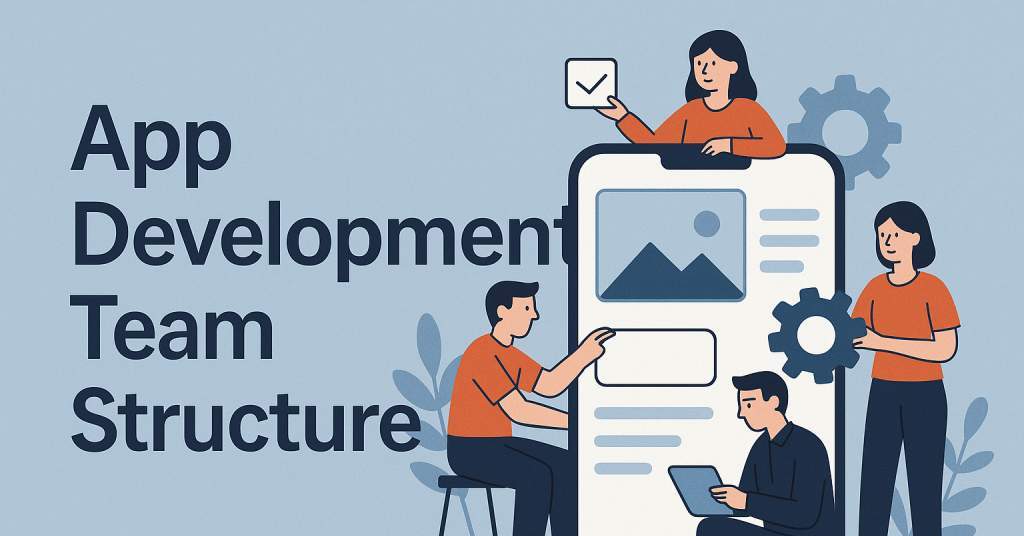
App Development Team Structure
A great mobile app starts with a great team.
But how do you build the right team for your project?
From developers to designers, every role plays a crucial part in the app's success. Without a well-structured team, delays, budget overruns, and poor-quality apps become inevitable.
This guide will walk you through how to build a mobile app team, its structure, and key roles to ensure your app turns into a success story.
Let’s get started!
Why Do You Need a Well-Structured Mobile App Development Team?
A mobile app isn’t just about coding.
It’s about creating a seamless experience for users.
A well-structured team ensures success by improving speed, quality, and cost efficiency. Let’s break it down.
1. Faster Development with Clear Role Distribution
When each team member knows their exact role, the workflow becomes smooth.
A Project Manager oversees progress, developers focus on coding, and designers handle UI/UX.
With this structure, tasks don’t overlap, and the project moves forward without unnecessary delays.
Without clear roles? Miscommunication, duplicated efforts, and missed deadlines become common.
2. Better Quality Through Expertise
Each phase of app development—planning, designing, coding, testing, and deployment—requires specialized skills.
A UI/UX designer ensures an intuitive interface.
A QA tester catches bugs before launch. Backend and frontend developers work together for seamless performance.
Skipping any of these roles? Expect usability issues, poor functionality, and negative user feedback.
3. Cost Efficiency by Avoiding Delays and Revisions
Building an app is an investment.
But poor planning and lack of expertise can lead to extra costs.
For example, if testing isn’t prioritized, fixing bugs post-launch costs 5X more than resolving them early. (Source: IBM)
A structured team minimizes rework, saving time, money, and resources.
4. Higher Success Rate
Did you know?
Apps with well-structured teams have a 30% higher success rate than those built with a disorganized approach. (Source: CB Insights)
If your goal is to launch a high-quality app on time and within budget, a strong team is your best asset.
Key Roles in a Mobile App Development Team
Building a successful app requires the right mix of technical, creative, and management experts.
Each role plays a crucial part in ensuring smooth development and high-quality output.
Let’s break them down.
|
Role |
Key Responsibilities |
Required Skills |
Why It's Important |
|
Project Manager |
Oversees planning, manages timelines, ensures smooth team collaboration, and keeps the project on track. |
Agile methodologies, risk management, communication, leadership, budgeting. |
Prevents miscommunication, delays, and budget overruns; ensures smooth project execution. |
|
Business Analyst |
Analyzes business needs, defines requirements, studies competitors, and bridges the gap between business and tech teams. |
Market research, data analysis, wireframing, requirement documentation, problem-solving. |
Aligns the app with business goals, reduces costly reworks, and enhances user satisfaction. |
|
UI/UX Designer |
Creates wireframes, prototypes, and user flows; ensures a seamless and visually appealing user experience. |
Graphic design, Figma/Adobe XD, user research, prototyping, interaction design. |
Ensures an intuitive, visually engaging, and user-friendly interface to improve retention. |
|
iOS Developer |
Develops, tests, and optimizes iOS apps using Swift or Objective-C; integrates Apple-specific features. |
Swift, Objective-C, UIKit, Xcode, Core Data, Apple APIs, debugging. |
Optimizes app performance on Apple devices; ensures compliance with iOS standards. |
|
Android Developer |
Builds and maintains Android apps using Kotlin or Java; ensures compatibility across multiple devices. |
Kotlin, Java, Android Studio, Jetpack, Firebase, REST APIs. |
Ensures smooth app functionality across diverse Android devices and OS versions. |
|
Cross-Platform Developer |
Develops apps that run on both iOS and Android using Flutter, React Native, or Xamarin. |
Flutter, React Native, Xamarin, Dart, JavaScript, mobile UI frameworks. |
Reduces development costs and time while supporting both major mobile platforms. |
|
Backend Developer |
Manages databases, APIs, and server-side functionalities; ensures app scalability and security. |
Node.js, Python, Ruby, database management, API development, cloud services. |
Handles data security, app performance, and scalability for long-term success. |
|
QA Engineer (Tester) |
Conducts functional, performance, and security testing; ensures the app is bug-free before launch. |
Automated/manual testing, Selenium, Appium, TestFlight, debugging tools. |
Ensures a polished, reliable, and secure app before it reaches users. |
|
DevOps Engineer |
Handles CI/CD, deployment, server optimization, and app monitoring to ensure stability. |
CI/CD pipelines, AWS, Azure, Kubernetes, Docker, cloud security. |
Prevents crashes, downtime, and slow performance; enhances app security. |
|
Marketing & Growth Strategist |
Executes ASO, paid campaigns, content marketing, and retention strategies to boost app visibility and downloads. |
SEO, ASO, paid ads, content marketing, growth hacking, analytics tools. |
Drives downloads, increases user engagement, and maximizes revenue potential. |
Each role is crucial to the success of your mobile app.
Want to know whether you should hire in-house or outsource? Let’s discuss that next!
How to Build a Mobile App Team – In-House vs. Outsourcing vs. Dedicated Team
Choosing the right approach to build your mobile app team is crucial.
Should you hire an in-house team, outsource development, or go with a dedicated team? Let’s break it down.
|
Factor |
In-House Team |
Outsourcing |
Dedicated Team |
|
Cost |
High |
Low |
Medium |
|
Control |
High |
Low |
Medium-High |
|
Scalability |
Limited |
High |
High |
|
Communication |
Easy |
Can be challenging |
Smooth |
|
Expertise |
Limited to in-house skills |
Access to global talent |
Skilled professionals on demand |
|
Best For |
Large enterprises |
Startups with limited budgets |
Businesses needing expert developers |
1. In-House Team – Full Control, But High Costs
An in-house team means hiring full-time employees for each role.
✅ Pros:
✔ Full control over development and workflow.
✔ Better communication and team collaboration.
✔ Faster problem-solving and project updates.
❌ Cons:
✖ High hiring and operational costs.
✖ Takes time to assemble a skilled team.
✖ Limited expertise—may need external consultants.
👉 Best for: Large enterprises and tech-focused businesses that need long-term development.
2. Outsourcing – Cost-Effective, But Requires Strong Management
Outsourcing means hiring a third-party company or freelancers to develop your app.
✅ Pros:
✔ Lower development costs.
✔ Access to a global talent pool.
✔ No need for in-house infrastructure.
❌ Cons:
✖ Communication challenges (especially with time zones).
✖ Risk of inconsistent quality.
✖ Less direct control over the project.
👉 Best for: Startups and businesses that need cost-effective, short-term solutions.
3. Dedicated Development Team – The Best of Both Worlds
A dedicated team is like having an in-house team without the hiring hassle.
✅ Pros:
✔ Full access to experienced developers and specialists.
✔ Cost-effective compared to in-house hiring.
✔ More control than outsourcing.
✔ Scalable—team size can be adjusted as needed.
❌ Cons:
✖ Requires a reliable partner to ensure quality.
✖ Might have initial setup and onboarding time.
👉 Best for: Businesses that need an expert team without long-term employee commitments.
Choosing the right team structure depends on your budget, timeline, and project complexity.
Next, let’s talk about team size and structure based on your app type.
Team Size and Structure for Different App Types
The size of your mobile app development team depends on your app’s complexity, target audience, and business goals.
Let’s break it down by different project sizes.
|
App Type |
Team Size |
Best For |
|
MVP (Basic App) |
4-6 members |
Startups testing an idea |
|
Medium-Scale App |
8-12 members |
Growing businesses with feature-rich apps |
|
Enterprise App |
15+ members |
Large-scale businesses with advanced needs |
1. MVP (Minimum Viable Product) – Small, Lean Team for Startups
If you’re building an MVP to test your idea, you need a small, agile team that can develop and launch quickly.
💡 Recommended Team Size: 4-6 members
🔹 Roles Required:
✔ Project Manager – To keep everything on track.
✔ UI/UX Designer – To create a simple, user-friendly interface.
✔ 1-2 Developers (iOS, Android, or Cross-Platform) – To build the app.
✔ QA Engineer – To test for bugs and functionality.
✅ Why?
- Minimizes costs while validating your idea.
- Fast development cycle to launch early.
- Focus on essential features only.
2. Medium-Scale App – Balanced Team for Growing Businesses
For apps with more features, multiple integrations, and higher user demand, you need a bigger team.
💡 Recommended Team Size: 8-12 members
🔹 Roles Required:
✔ Project Manager – To oversee execution and timelines.
✔ Business Analyst – To ensure market fit and feasibility.
✔ UI/UX Designer – To enhance user experience.
✔ 2-3 Developers (iOS, Android, or Backend) – To manage development.
✔ Backend Developer – To handle databases and APIs.
✔ QA Engineer – To conduct testing and debugging.
✔ DevOps Engineer – To ensure deployment and security.
✅ Why?
- Supports more complex features.
- Handles higher traffic and scalability.
- Enables multi-platform development (iOS, Android, Web).
3. Enterprise-Level App – Large Team for Complex Applications
If you’re building a high-performance enterprise app, you need a dedicated team with specialists in different areas.
💡 Recommended Team Size: 15+ members
🔹 Roles Required:
✔ Project Manager – To manage team coordination.
✔ Business Analyst – To align app features with business objectives.
✔ UI/UX Designer – To create detailed UI components.
✔ Frontend Developers – To build the app interface.
✔ Backend Developers – To handle server-side logic.
✔ QA Engineers – To conduct extensive testing.
✔ DevOps Engineers – To manage infrastructure, security, and deployment.
✔ Marketing & Growth Strategist – To drive downloads and user engagement.
✅ Why?
- Ensures high security, scalability, and compliance.
- Allows seamless integration with existing enterprise systems.
- Supports complex AI, ML, or big data features.
Choosing the right team size ensures smooth development without overspending on unnecessary resources.
Next, let’s discuss best practices for managing your mobile app development team.
Best Practices for Managing a Mobile App Development Team
A well-structured team is just the beginning.
Managing your team effectively is what ensures success.
Here are some best practices to keep your development process smooth and efficient.
1. Clear Communication & Collaboration
Without clear communication, even the best teams struggle.
✅ Use project management tools like Jira, Trello, or Asana.
✅ Hold daily or weekly stand-up meetings to track progress.
✅ Use Slack or Microsoft Teams for quick updates.
📌 Why it matters?
- Avoids misunderstandings.
- Keeps everyone aligned on goals and deadlines.
- Boosts overall productivity.
2. Follow an Agile Development Approach
Agile development helps teams adapt quickly and deliver features faster.
✅ Break the project into sprints (2-4 week development cycles).
✅ Conduct frequent testing and iterations instead of waiting until the end.
✅ Get real-time feedback to improve continuously.
📌 Why it matters?
- Reduces risks by fixing issues early.
- Keeps development flexible and efficient.
- Speeds up time-to-market.
3. Regular Testing & Quality Assurance
Testing should be ongoing, not just before launch.
✅ Use automated testing tools like Selenium and Appium.
✅ Perform manual testing to catch UI/UX issues.
✅ Run security and performance tests regularly.
📌 Why it matters?
- Prevents post-launch failures and crashes.
- Saves time and money by detecting bugs early.
- Improves app stability and user experience.
4. Prioritize Scalability & Security
Think long-term—your app should handle growth without breaking.
✅ Use scalable cloud services like AWS, Google Cloud, or Azure.
✅ Follow secure coding practices to prevent cyber threats.
✅ Plan for future updates and feature expansions.
📌 Why it matters?
- Ensures the app can handle increasing users.
- Protects user data and prevents security breaches.
- Reduces downtime and performance issues.
5. Set Clear Milestones & Deadlines
A project without clear milestones can drag on indefinitely.
✅ Define deliverables for each sprint.
✅ Use Gantt charts or roadmaps for tracking.
✅ Set realistic deadlines to avoid burnout.
📌 Why it matters?
- Keeps development on schedule.
- Helps track progress effectively.
- Reduces bottlenecks and delays.
6. Keep the Team Motivated
A motivated team delivers better results.
✅ Recognize achievements and celebrate small wins.
✅ Encourage feedback and open discussions.
✅ Offer learning opportunities to keep skills updated.
📌 Why it matters?
- Keeps morale high and productivity strong.
- Encourages creativity and innovation.
- Reduces burnout and turnover.
Managing your app development team well can be the difference between a smooth launch and a failed project.
TEAM4SOLUTION– The Right Partner for Your Mobile App Development
Building a mobile app team from scratch can be time-consuming and expensive.
But what if you could get a ready-to-go, expert team without the hiring hassle?
At TEAM4SOLUTION, we provide dedicated mobile app development teams tailored to your project needs.
Whether you need iOS, Android, or cross-platform development, we have skilled developers, designers, and testers ready to bring your app idea to life.
✅ What We Offer:
✔ Experienced app developers with expertise in the latest technologies.
✔ Agile development process for faster, high-quality delivery.
✔ Scalable team structure—expand or downsize as per your needs.
✔ Transparent pricing with no hidden costs.
Want to build your app without the hassle of recruitment and team management?
Let’s connect and get started today!
Conclusion
Building a successful mobile app isn’t just about having a great idea—it’s about having the right team to execute it.
From project managers and developers to UI/UX designers and QA testers, every role plays a vital part in ensuring smooth development, high performance, and a great user experience.
The key to success?
✅ Choose the right team structure—in-house, outsourced, or a dedicated team.
✅ Define roles clearly to ensure efficiency.
✅ Follow best practices for communication, testing, and project management.
With a well-structured and managed mobile app team, you can launch your app faster, reduce costs, and maximize user satisfaction.
Need expert developers to build your dream app? Let’s make it happen!
FAQs
1. What is the ideal team size for mobile app development?
The ideal team size depends on the app’s complexity:
- MVP (Basic App) – 4-6 members.
- Medium-Scale App – 8-12 members.
- Enterprise App – 15+ members.
A small team works for startups, while complex apps need a full-fledged development team with specialized roles.
2. Should I hire an in-house team or outsource mobile app development?
It depends on your budget, timeline, and control requirements:
- In-house team – Best for long-term projects but requires high investment.
- Outsourcing – Cost-effective but requires good project management.
- Dedicated Team – A balance between cost, quality, and flexibility.
3. What are the most important roles in a mobile app development team?
Every project needs core team members, including:
- Project Manager – Manages timelines and communication.
- Developers (iOS, Android, Backend) – Build the app.
- UI/UX Designer – Designs user-friendly interfaces.
- QA Tester – Ensures bug-free performance.
- DevOps Engineer – Handles deployment and security.
- Marketing Strategist – Drives app downloads and engagement.
4. How much does it cost to build a mobile app team?
The cost varies based on team size, expertise, and location:
- In-house team – Can cost $100,000+ per year per developer in some regions.
- Outsourcing – Typically $20,000 to $80,000 per project based on complexity.
- Dedicated Team – Flexible pricing, depending on project scope.
5. How do I ensure my mobile app team works efficiently?
- Use Agile methodology for quick iterations.
- Conduct regular testing to fix issues early.
- Set clear milestones and deadlines.
- Encourage open communication with tools like Slack or Jira.
A well-managed team delivers better quality, faster development, and cost savings.




